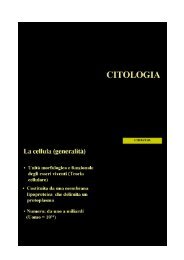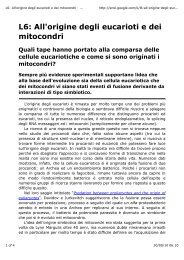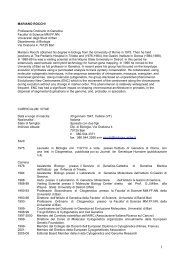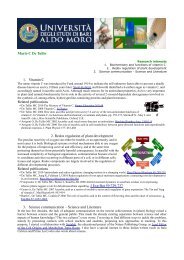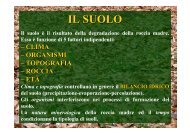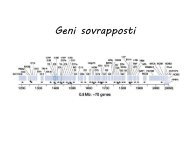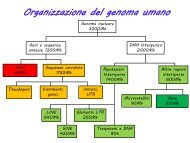mitochondrial dna mutations in human disease - The Rare ...
mitochondrial dna mutations in human disease - The Rare ...
mitochondrial dna mutations in human disease - The Rare ...
You also want an ePaper? Increase the reach of your titles
YUMPU automatically turns print PDFs into web optimized ePapers that Google loves.
REVIEWS<br />
a<br />
b<br />
GERMINAL VESICLE<br />
A stage dur<strong>in</strong>g oocyte<br />
maturation <strong>in</strong> which the<br />
oocyte nucleus is located<br />
close to the surface of the egg<br />
cell and is clearly visible.<br />
Germ<strong>in</strong>al vesicle removed<br />
Pronuclei removed<br />
Mutant mitochondrion<br />
Normal mitochondrion<br />
Pronucleus<br />
Figure 4 | Nuclear transfer techniques. <strong>The</strong> prevention of mutated maternal mtDNA<br />
transmission could be achieved by nuclear transfer techniques. In theory, this could be carried<br />
out at the germ<strong>in</strong>al vesicle stage (a), when clearly identifiable structures are visible. <strong>The</strong> germ<strong>in</strong>al<br />
vesicle conta<strong>in</strong>s nuclear chromosomes and could be transferred to an oocyte that conta<strong>in</strong>s<br />
normal mtDNA (green). Alternatively, pronuclear transfer can be carried out at the fertilized oocyte<br />
stage (b); this <strong>in</strong>volves removal of the male and female pronuclei from the oocyte that conta<strong>in</strong>s<br />
mutated mtDNA (red) and their subsequent transfer to an oocyte that has normal mtDNA (green).<br />
<strong>The</strong> high number of <strong>mitochondrial</strong> genomes with<strong>in</strong><br />
oocytes 124 <strong>in</strong>dicates that PGD should be feasible for<br />
mtDNA <strong>disease</strong>. Experiments <strong>in</strong> heteroplasmic mice<br />
have shown the levels of heteroplasmy to be virtually<br />
identical between the ooplasm and polar body of the<br />
mature oocyte and also between blastomeres of each of<br />
the 2-, 4-, and 6–8-cell embryo 125 .<br />
Alternative strategies associated with oocyte manipulation.<br />
Development of new strategies to prevent the<br />
transmission of mtDNA is a very important aspect of<br />
<strong>disease</strong> management. An obvious method to prevent the<br />
transmission of an mtDNA mutation to the offspr<strong>in</strong>g is<br />
oocyte donation. However, although the oocyte would<br />
be fertilized us<strong>in</strong>g the father’s sperm, the child would<br />
have the nuclear genotype of the donor female, a lessthan-ideal<br />
option for many mothers. Cytoplasmic<br />
transfer <strong>in</strong>volves the transfer of normal mitochondria<br />
<strong>in</strong>to the abnormal oocyte to dilute the effect of any<br />
mtDNA defect 126 . Cytoplasmic transfer between <strong>human</strong><br />
oocytes has been carried out to improve the outcome<br />
of assisted reproduction methods 127 . <strong>The</strong> effectiveness<br />
of this procedure is uncerta<strong>in</strong> 128 , but some of the<br />
children born were heteroplasmic with low levels of<br />
mtDNA from the donor oocyte 129 . However, despite the<br />
observation that changes <strong>in</strong> heteroplasmy can occur, it<br />
is likely that this technique will have limited value for<br />
patients with mtDNA <strong>disease</strong>, as mouse experiments<br />
<strong>in</strong>dicate that the amount of mtDNA that can be transferred<br />
is relatively small 130 .<br />
Alternatively, nuclear chromosomes from an<br />
oocyte that conta<strong>in</strong>s mutated mtDNA could be<br />
transferred to an enucleated oocyte from a normal<br />
female 131 . This method has obvious advantages: the<br />
offspr<strong>in</strong>g will be genetically related to both parents<br />
and the chances of achiev<strong>in</strong>g very low levels of<br />
mutated mtDNA <strong>in</strong> the oocyte are high. However,<br />
important technical and ethical or legal issues make<br />
progress <strong>in</strong> this area difficult, pr<strong>in</strong>cipally because the<br />
technique <strong>in</strong>volves the genetic manipulation of fertilized<br />
oocytes. To overcome these issues, the transfer<br />
could be carried out at different stages of oocyte<br />
maturation, although transfer from mature unfertilized<br />
oocytes is difficult because of the serious risk<br />
of aneuploidy that is due to chromosome loss dur<strong>in</strong>g<br />
transfer or due to missegregation follow<strong>in</strong>g the disruption<br />
of the meiotic sp<strong>in</strong>dle. Karyoplast transfer of<br />
the GERMINAL VESICLE between oocytes might be possible<br />
before <strong>in</strong> vitro maturation and subsequent fertilization<br />
(FIG. 4). However, although maturation and<br />
fertilization of normal germ<strong>in</strong>al-vesicle-stage oocytes<br />
has been achieved with both mouse 132–134 and <strong>human</strong><br />
oocytes 135,136 , these methods are very <strong>in</strong>efficient.<br />
Pronuclear-stage transfer is possibly more feasible<br />
because <strong>human</strong> pronuclear oocytes can be manipulated<br />
to generate normal offspr<strong>in</strong>g 137 and because this<br />
technique is feasible <strong>in</strong> the mouse 138,139 .<br />
Acquired mtDNA <strong>mutations</strong> <strong>in</strong> age<strong>in</strong>g and cancer<br />
Mitochondrial theory of age<strong>in</strong>g. <strong>The</strong> <strong>mitochondrial</strong><br />
theory of age<strong>in</strong>g proposes that progressive accumulation<br />
of somatic <strong>mutations</strong> <strong>in</strong> mtDNA dur<strong>in</strong>g a lifetime<br />
leads to an <strong>in</strong>evitable decl<strong>in</strong>e <strong>in</strong> <strong>mitochondrial</strong> function<br />
140 . <strong>The</strong> most important biochemical factors <strong>in</strong> this<br />
process are considered to be reactive oxygen species<br />
(ROS), which are generated at very low levels dur<strong>in</strong>g<br />
the normal function of the <strong>mitochondrial</strong> respiratory<br />
cha<strong>in</strong>. It has been proposed that ROS can cause somatic<br />
<strong>mutations</strong> <strong>in</strong> mtDNA 140 . <strong>The</strong>se <strong>mutations</strong> then result<br />
<strong>in</strong> impaired function of the respiratory cha<strong>in</strong>, lead<strong>in</strong>g<br />
to <strong>in</strong>creased ROS production and the subsequent<br />
accumulation of more <strong>mutations</strong>. <strong>The</strong>re is evidence<br />
that some pathogenic <strong>mutations</strong>, such as at 8993T>G,<br />
lead to <strong>in</strong>creased ROS production 141 ; <strong>in</strong>terest<strong>in</strong>gly, for<br />
8993T>G, free radical-mediated <strong>in</strong>hibition of OXPHOS<br />
can be restored by antioxidants 142 . <strong>The</strong> ROS vicious<br />
cycle is believed to account for an exponential <strong>in</strong>crease<br />
<strong>in</strong> oxidative damage dur<strong>in</strong>g age<strong>in</strong>g, which results <strong>in</strong> the<br />
eventual loss of cellular and tissue functions through a<br />
comb<strong>in</strong>ation of energy <strong>in</strong>sufficiency, signall<strong>in</strong>g defects,<br />
apoptosis and replicative senescence.<br />
Studies <strong>in</strong> <strong>human</strong> and mouse models. Although<br />
the <strong>mitochondrial</strong> theory of age<strong>in</strong>g was first suggested<br />
<strong>in</strong> the 1950s, the first conv<strong>in</strong>c<strong>in</strong>g evidence of a<br />
398 | MAY 2005 | VOLUME 6 www.nature.com/reviews/genetics<br />
© 2005 Nature Publish<strong>in</strong>g Group





